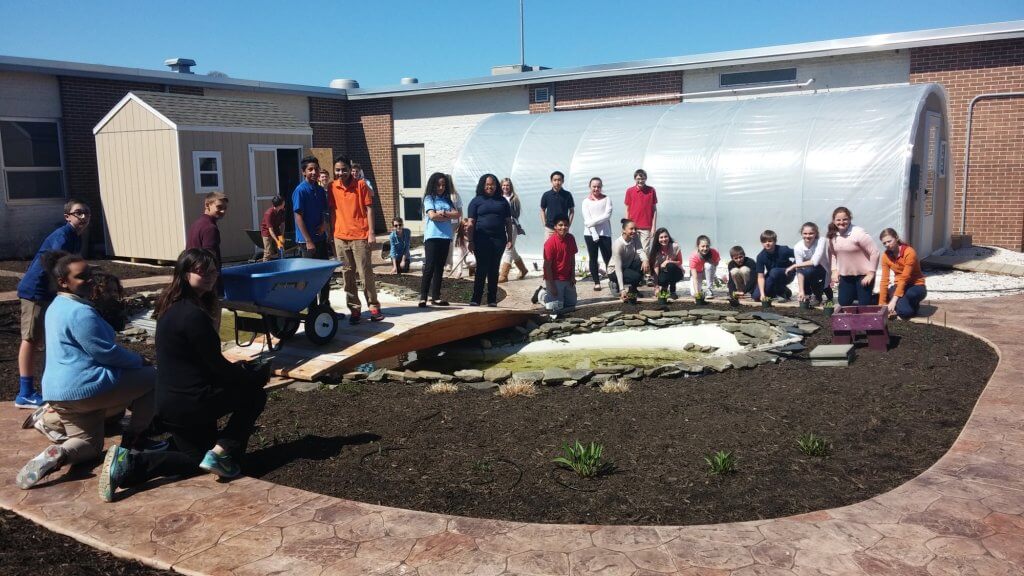COURT HOUSE – Bring together student and faculty energy plus community-minded businesses to lend talents and expertise, add some state funds and a vision and you’ll end up with an outdoor classroom that can be used throughout the year to teach students about living off the land in a healthy manner.
“Never in my wildest dreams would I have imagined something like this could come together in such a short time,” Middle Township Middle School Principal Dr. Toni Anne Lehman said. “It is something that will flourish every year as well. It was a great project bringing together the community with our schools.”
The project Lehman referred to is a transformed student courtyard that boasts a greenhouse, flowers, vegetables, plants, shed, bridge and a pond that came together under three grants obtained by Susan Blood, who teaches Science, Math and a STEM-based (Science, Technology, Engineering, Math) course at the school.
Grants were obtained from Sustainable Jersey for Schools, a new organization for public schools that want to “go green, conserve resources and take steps to create a brighter future.”
Two grants, for $10,000 and $2,000, were general and could be used to help the school achieve action items toward Sustainable Jersey for Schools’ certification.
A third grant, for $4,000, was a Wellness Grant used to start a Wellness After School Club.
“We chose to write a grant for the outdoor classroom to help educate students, teachers, parents and community members on sustainability efforts related to the benefits that native plants bring to native pollinators,” explained Blood, “and to teach procedures for year-round gardening.
“I was amazed at the voluntary support from community members and teachers,” she added, “and was continually pleased with the willingness of students to get their hands dirty and be so actively involved in the project.”
More than 630 hours were donated.
Blood said the grant was announced last June 19, and “we immediately started calling contractors for our walkway and shed construction. Lenny Catanoso from Garden Greenhouse and Nursery, Court House, donated his time to design the new courtyard.”
Within the month, a rotted bridge, benches and wood were removed to make way for the new design. “There had been a garden with vegetables here,” Blood said, “but the whole space required too much maintenance. We thought by making it a classroom, the students, especially sixth graders who study plants during science, would be able to make use of it.”
Blood said students cleaned, removed dead plants, planted new growth, mulched and laid stones around the courtyard. Cape Concrete Design installed a stamped concrete walkway that presented its own challenges because the cement had to be transferred through the school. A pond was cleaned, prepped and repainted beige for a “natural look and allow students to see pond organisms more clearly.”
In addition, over 120 native plants from Clemenson Farms Native Nursery, Estell Manor, were planted over the summer by 13 volunteers, including faculty, family members, and students. Another student planted bulbs to brighten the area in the spring.
“We had a minor setback when the courtyard flooded last August,” Blood said, “because of a drainage issue combined with a very bad storm. It happened just a few days after we were done with everything except the greenhouse and drip irrigation system. It was promptly repaired by our Building and Grounds team and we now have a four-zone drip irrigation system that should prevent that in the future.”
At one time, Blood said a section of the courtyard apparently had been a memorial to students who died while attending school there. “We found an angel in the courtyard when we were removing things, so we set it aside. I’ve tried to find out the history behind it, but haven’t been able to yet. Our plan is to have a dedication ceremony and re-dedicate the courtyard in memory of our students.”
A shed for storage of gardening tools was built from a kit by two retired cabinet makers and a retired Coast Guardsman, Blood said.
“Dave Moyer, the industrial arts teacher, used his personal mill to cut down a local cedar and locust tree to build the bridge. His seventh grade class decided to build the bridge as a class project, instead of everyone doing their own individual project.”
Another teacher, Gary Rhile, built the greenhouse from a kit, which allows students to begin plants from seeds, watering and caring for them, then transplanting them when they outgrow pots.
“Nine raised beds were built from plastic lumber since it can last for years without maintenance,” Blood said. “Students will be transplanting lettuce, parsnips, onions, kale, parsley and Swiss chard once the weather warms.”
To integrate all facets into the learning experience, Blood said some teachers are showing students how to eat healthy salads. “My science class has already used it and Mr. Rhile’s seventh grade students are learning about the bee hives,” Blood said.
“Math teachers can calculate the area and volume of the raised beds, the greenhouse and the shed; the art teacher can have students draw different native plants; Social Studies teachers can use it to talk about the drip irrigation system and how water resources are becoming limited, and Science teachers can use it for their life science curriculum and the impact on invasive plants to pollinators.
“All teachers will have access to the fruit and vegetables to make healthy recipes in their classrooms in conjunction with other wellness efforts,” she added.
The after-school program began a Pink Panthers Wellness Club under the direction of teachers Sharon Rementer, Sue Pohle and Monica DeRose, and has already included healthy cooking demonstrations and exercise classes such as Zumba in their program.
“Part of the grant was used to purchase a blender so we are looking at showing the students how to make kale smoothies,” Blood added. “We also bought a Spiralizer to show them how to make zucchini noodles.
“It is early yet to feel that we have fully achieved our goal,” she said. “When the signs are posted, the plants are blooming and the temperatures are warmer, our intent is that it will be used by many teachers for various lessons and then we will have achieved our goal.”
To contact Karen Knight, email kknight@cmcherald.com.
Dennis Township – The parents of Dennis Township need to know that their children are not receiving Basic Skills Services. The BSI teacher has been “acting principal” and doing way more admin work than actually…








